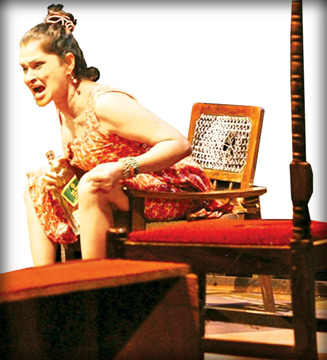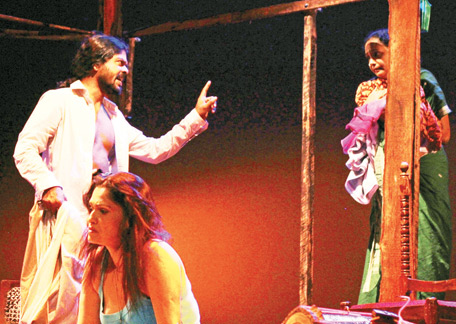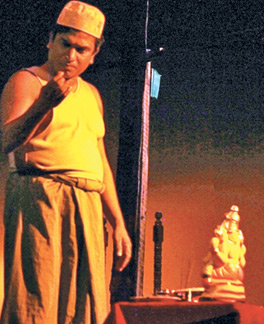|
Drama review
Daasa Mallige Bungalawa :
Impressive performances
by Dilshan Boange
Part 2
 One of the significant aspects that lends to the understanding of the
inner being of Daasa as well as a cultural and psychological premise to
gauge the positions in which the characters are to be found, is in the
arrival of the idol of God Ganesh or ‘Ganapathy’. Lechchami, a Hindu
woman is shown to be extremely religious. However, rituals seem
nonsensical to Daasa. He makes some changes to his daily routine to
please Lechchami. For instance, he joins her in religious rituals. He
thinks that she should consider it a great sacrifice. One of the significant aspects that lends to the understanding of the
inner being of Daasa as well as a cultural and psychological premise to
gauge the positions in which the characters are to be found, is in the
arrival of the idol of God Ganesh or ‘Ganapathy’. Lechchami, a Hindu
woman is shown to be extremely religious. However, rituals seem
nonsensical to Daasa. He makes some changes to his daily routine to
please Lechchami. For instance, he joins her in religious rituals. He
thinks that she should consider it a great sacrifice.
His behaviour shows that there is a need to develop a personal bond
with every woman he brings home to be his housekeeper-cum-companion.
Yet it is within very strict demarcations of disallowing the woman to
become the custodian of the house. What is interesting to note is that
despite the fact that he casts Lechchami out of the house, the image of
Lord Ganesh and the altar of worship continue to exist. But he thinks
that religion is utterly useless.
The late Prime Minister of India Indira Ghandi, in an interview with
a foreign magazine said, “Indians are not a god-fearing people, they are
a god-loving people.” The different gods in the Hindu pantheon allow
devotees to chose any god they prefer depending on their character
traits.
But to Daasa, it all seems juvenile yet tolerable. His understanding
of religion does not involve any ideological underpinnings since he
seems nothing wrong with his best friend Bawa taking part in making the
offerings to God Ganesh when Lechchami strongly opposes it saying that
Bawa is a Muslim and he is disqualified from having a hand in the
ritual.
Adaptation
Based on the fact that the play is an adaptation of an Indian play I
was wondering whether the original also has a protagonist whose attitude
towards the religious devotions of the ‘first female’ is just as
irreligious or was it developed more on the lines as a scenario
depicting a Sinhala man thinking snidely of the religious devotions of a
Tamil Hindu woman.
There is enough evidence in dialogues that Daasa views Lechchami’s
level of religiousness as a trait related to her community since he says
the woman before her was also constantly engaged in acts of professing
devotion which included worshipping a shirt owned by her husband who
cast her out.
A senseless devotion as stated by Daasa which renders women such as
Lechchami a puzzle to him. The manner in which Daasa comments about the
image of God Ganesh also renders him an unapologetically irreverent man.
That ‘premise’ of the triangular connection between Daasa, Lechchami
and Ganapathy is one that allows ‘space’ for much theorisation about the
role religion plays in human relations in Daasa’s abode.
|

Scenes from the play |
The nature of the characters are such that they are brought to life
to evoke emotions of either empathy or resentment or both. One may say
that Lechchami may not attract censure from anyone, I found her acting
for self survival.
Some characters display attributes that are deplorable. For instance,
Indrapala’s pathetic slavishness to the woman who berates him, or Bawa’s
sneaky opportunism to satisfy his lust with Champika, can be cited.
Politics of laughter
The celebrated postmodern novelist Milan Kundera in his
quasi-biographical novel The Book of Laughter and Forgetting speaks of
the politics of laughter and the manifold significances a laugh can have
in relation to the ‘laugher’ as well as the people who perceive the
laughter.
Laughter becomes a reason for gruesome beatings to happen in the
drama. And how laughter is an objective of many a theatregoer in Sri
Lanka is a topic that must be looked at in the context of this drama.
Lechchami’s friendship with an ant with whom she is discovered
conversing attracts Daasa’s intrigue, bemusement and amusement.
The laughter that he hears coming out of her when talking to the ant
begins to kindle in him a desire to hear that element of ‘femininity’
recurring in his presence.
He shows a desire for it yet when denied it ‘on call’, is persistent
of his demand. When meted with lack of complicity by Lechchami the
result is severe manhandling and brutal power play to depict that he
doesn’t tolerate defiance of his commands, especially if they are
connected to some sensitive aspect within him.
Lechchami’s cries that erupt are a deftly delivered blend of laughter
and wails that blur the lines between tears of laughter and those of
pain. There is irony that is ripe to befuddle the viewer as to whether
she is crying out in jest and humouring Daasa and defeating his
dominance attempted over her sought a belt she is being lashed with, or
whether she is giving cries of laughter that is self mockery at her own
pitiful plight and the existence that is absurd to her? Or is it clear
cut cries of pain?
The answer is perhaps, that it is the flux of these different
emotions within Lechchami finding form as an oral expression. On this
aspect Ravini Anuradha who played Lechchami must be saluted for her
prowess as an actress.
Gestures
There was laughter that erupted from the audience at the threatening
gestures made by Daasa to Lechchami when the former was truculently
demanding the latter to laugh.
Yes, it is absurd to think that someone would make a request like
that and then keep insisting on it.
The demeanour of Daasa as created by Jayantha Muthuthantri at that
moment may make him seem moronic and possibly be seen as an object to
laugh at, but what I experienced to my dismay was that the inability of
many viewers that night to catch on to the significance of those
threatening gestures that were precursors to the violence done on
Lechchami.
Once the belting got underway the laughter died among the viewers,
but it also showed a dimmed sensitivity as to how Daasa’s words, the
gesture and tone could not be seen as the ‘promise of violence’ unless
his orders are obeyed.
That was no laughing matter. At the point when there was that
confusion created through the variance of tone of the cries by Lechchami
to confuse the viewer as to whether she was crying in pain or laughing
sardonically, laughs cropped up from here and there in the audience.
And I was rather disturbed about what those audience reactions
indicated about the people who watch theatre.
 Perhaps there is a preconception among most theatregoers in Sri Lanka
that theatre is about a performance purely for enjoyment and that
enjoyment involves junctures that evoke laughter. I wondered whether it
is the influence of sitcoms that may attune a viewer to be cued for
laughter the very moment something seems a bit absurd and amusing. Perhaps there is a preconception among most theatregoers in Sri Lanka
that theatre is about a performance purely for enjoyment and that
enjoyment involves junctures that evoke laughter. I wondered whether it
is the influence of sitcoms that may attune a viewer to be cued for
laughter the very moment something seems a bit absurd and amusing.
Merciless
When commenting on how theatre connects with society and what role
and relevance it has to the community at large as a medium of art that
reflects realities in society as a live performance, I believe what I
experienced offers much food for thought. And what may be reasonably
deduced as to possible reflections of society may be disturbing.
At the point where Lechchami is given her most severe belting, where
she is down on the ground and Daasa’s hand moves in merciless velocity
the stillness in the audience was intense. The crack of the belt against
the wooden boards was like a gag put on the audience.
And as the whipping intensified I actually heard the voice of a small
child ask (presumably a parent) in Sinhala, whether the beating was for
real? The action was theatricalised so compellingly that it was almost
powerful to make a child wonder if there was actual physical harm being
done.
For instance, domestic violence may touch a disturbing chord in small
children. The ineptness of some viewers to grasp the nuanced gesture of
impending violence, which was taken for a ‘laughing matter’ of a comedic
nature, would create the wrong impression in children who are of course
there with elders and taking in the experience of watching a drama as
something of a ‘collective experience’.
What connections between the action on stage and the corresponding
audience reactions that occur may lend to how children make meaning of
their experience.
And another feature of the drama, which renders this production as
unfit for children is the coarsely foul language spoken in some parts of
dialogue.
My sole aim is to offer some food for thought as to the likely
susceptibilities of juvenile audiences when a story that contains
sensitive elements are shown on stage.
Daasa Mallige Bungalawa is a powerful piece of theatre. The impactful
performance that came alive on the boards on July 23 at the Lionel Wendt
Theatre must be applauded for the strength of talent shown by a cast
composed mainly of relatively lesser known faces in the domain of drama
and theatre.
A drama such as this will evoke in the average theatregoer a
conscientious afterthought by consciously grasping the deeper
significances of what are finely nuanced to reach deep into our
collective conscience as people. |

